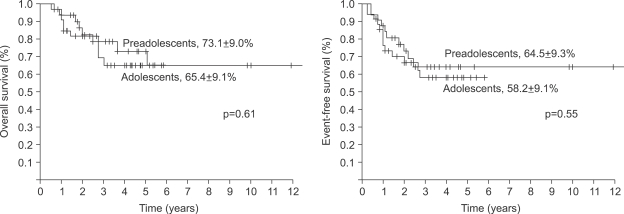Cancer Res Treat.
2007 Dec;39(4):160-164.
The Survival of Osteosarcoma Patients 10 Years Old or Younger Is Not Worse than the Survival of Older Patients: A Retrospective Analysis
- Affiliations
-
- 1Department of Pediatrics, Korea Cancer Center Hospital, Seoul, Korea.
- 2Department of Orthopedic Surgery, Korea Cancer Center Hospital, Seoul, Korea. dgjeon@kcch.re.kr
Abstract
-
PURPOSE: This study aimed to assess whether a young age at the time of diagnosis with osteosarcoma has value to predict the prognosis.
MATERIALS AND METHODS
Sixty-seven children with stage II osteosarcoma were stratified according to the age of 10. There were 32 preadolescents (< or =10 years) and 35 adolescents (10 < age < or = 15 years). The patients were analyzed for their clinical characteristics, the histologic response to preoperative chemotherapy, event-free survival (EFS) and the patterns of relapse.
RESULTS
After a median follow-up of 54 months (range: 6~153 months), the 5-year EFS of the preadolescent and adolescent groups was 64.5+/-9.3% and 58.2+/-9.1%, respectively, and age did not have any statistical significance for survival (p=0.55). Cox regression analysis revealed that both the serum level of alkaline phosphatase and the histologic response to preoperative chemotherapy were significantly related to survival of the 67 patients. Those patients aged less than 7 years responded poorly to preoperative chemotherapy and their rate of amputation was 43%. However, their 5-year EFS was not statistically different from the older patients (57.1+/-18.7 vs 67.7+/-6.3%, respectively, p=0.58).
CONCLUSIONS
We could not find any statistical difference in the clinical characteristics and survival from osteosarcoma for the preadolescents and adolescents, so the current approach of having the same protocol for both groups of patients seems to be reasonable.
Keyword
MeSH Terms
Figure
Reference
-
1. Grovas A, Fremgen A, Rauck A, Ruymann FB, Hutchinson CL, Winchester DP, et al. The national cancer data base report on patterns of childhood cancers in the united states. Cancer. 1997; 80:2321–2332. PMID: 9404710.
Article2. van den Berg H, van der Lelie J. Acute lymphoblastic leukaemia in puberty and adolescence. Ann Oncol. 2000; 11:1375–1379. PMID: 11142474.
Article3. Silverman LB, Sallan SE. Newly diagnosed childhood acute lymphoblastic leukemia: update on prognostic factors and treatment. Curr Opin Hematol. 2003; 10:290–296. PMID: 12799535.
Article4. London WB, Castleberry RP, Matthay KK, Look AT, Seeger RC, Shimada H, et al. Evidence for an age cutoff greater than 365 days for neuroblastoma risk group stratification in the children's oncology group. J Clin Oncol. 2005; 23:6459–6465. PMID: 16116153.
Article5. Maris JM, Hogarty MD, Bagatell R, Cohn SL. Neuroblastoma. Lancet. 2007; 369:2106–2120. PMID: 17586306.
Article6. Buckley JD, Pendergrass TW, Buckley CM, Pritchard DJ, Nesbit ME, Provisor AJ, et al. Epidemiology of osteosarcoma and ewing's sarcoma in childhood: a study of 305 cases by the children's cancer group. Cancer. 1998; 83:1440–1448. PMID: 9762947.7. Scranton PE, DeCicco FA, Totten RS, Yunis EJ. Prognostic factors in osteosarcoma. A review of 20 year's experience at the university of pittsburgh health center hospitals. Cancer. 1975; 36:2179–2191. PMID: 1060506.
Article8. Winkler K, Beron G, Delling G, Heise U, Kabisch H, Purfurst C, et al. Neoadjuvant chemotherapy of osteosarcoma: Results of a randomized cooperative trial (COSS-82) with salvage chemotherapy based on histological tumor response. J Clin Oncol. 1988; 6:329–337. PMID: 2448428.
Article9. Fuchs N, Bielack SS, Epler D, Bieling P, Delling G, Korholz D, et al. Long-term results of the co-operative german-austrian-swiss osteosarcoma study group's protocol COSS-86 of intensive multidrug chemotherapy and surgery for osteosarcoma of the limbs. Ann Oncol. 1998; 9:893–899. PMID: 9789613.
Article10. McKenna RJ, Schwinn CP, Higinbotham NL. Osteogenic sarcoma in children. Calif Med. 1965; 103:165–170. PMID: 14341315.
Article11. Winkler K, Beron G, Kotz R, Salzer-Kuntschik M, Beck J, Beck W, et al. Neoadjuvant chemotherapy for osteogenic sarcoma: Results of a cooperative German/Austrian study. J Clin Oncol. 1984; 2:617–624. PMID: 6202851.
Article12. Hudson M, Jaffe MR, Jaffe N, Ayala A, Raymond AK, Carrasco H, et al. Pediatric osteosarcoma: therapeutic strategies, results, and prognostic factors derived from a 10-year experience. J Clin Oncol. 1990; 8:1988–1997. PMID: 2230890.
Article13. Kozakewich H, Perez-Atayde AR, Goorin AM, Wilkinson RH, Gebhardt MC, Vawter GF. Osteosarcoma in young children. Cancer. 1991; 67:638–642. PMID: 1985758.
Article14. Rytting M, Pearson P, Raymond AK, Ayala A, Murray J, Yasko AW, et al. Osteosarcoma in preadolescent patients. Clin Orthop Relat Res. 2000; 373:39–50. PMID: 10810461.
Article15. Greene FL. The American joint committee on cancer: Updating the strategies in cancer staging. Bull Am Coll Surg. 2002; 87:13–15. PMID: 17387902.16. Rosen G, Marcove RC, Huvos AG, Caparros BI, Lane JM, Nirenberg A, et al. Primary osteogenic sarcoma: eight-year experience with adjuvant chemotherapy. J Cancer Res Clin Oncol. 1983; 106(Suppl):55–67. PMID: 6604058.
Article17. Bacci G, Longhi A, Bertoni F, Bacchini P, Ruggeri P, Versari M, et al. Primary high-grade osteosarcoma: comparison between preadolescent and older patients. J Pediatr Hematol Oncol. 2005; 27:129–134. PMID: 15750443.
- Full Text Links
- Actions
-
Cited
- CITED
-
- Close
- Share
- Similar articles
-
- Primary Osteosarcoma in Patients Older than 40 Years of Age
- Consecutive Esodeviation After Exotropia Surgery in Patients Older than 15 Years: Comparison with Younger Patients
- Osteosarcoma in Korean children and adolescents
- Survival Rate of Patients with Colorectal Cancer Younger than 40 Years
- The Clinical Significance and Prognosis of Korean Young Age (younger or 35 year old) onset Breast Cancer


